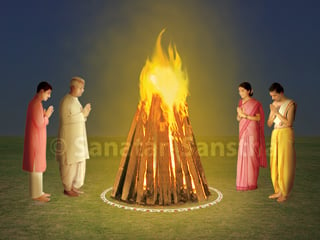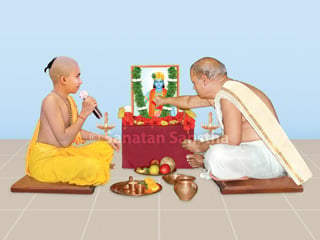One of the 3-1/2 muhurtas (auspicious period)
Akshay Tritiya is an Indian festival celebrated on Vaishakh Shukla Tritiya (Third day of the bright fortnight of the Hindu lunar month of Vaishakh). This day is celebrated as festival and is observed as a vrat also. So apart from buying gold, this day is also associated with offering generous donations and rituals such as ‘Til-tarpan’ and ‘Udak-kumbh’. It is one among the 3-1/2 muhurtas. It is also the day when Satyayuga ended and Tretayuga began.
A day that imparts eternal benefits on making offerings!
It has been stated in the ancient Sanskrit text Madanratna that Bhagavan Shri Krishna has narrated importance of this day to Yudhishthir. Shri Krishna says,
अस्यां तिथौ क्षयमुर्पति हुतं न दत्तं । तेनाक्षयेति कथिता मुनिभिस्तृतीया ।।
उद्दिश्य दैवतपितृनि्क्रयते मनुष्यैः । तत् च अक्षयं भवति भारत सर्वमेव ।। – मदनरत्न
Meaning : O Yudhishthir, the offerings and the oblations offered in the sacrificial fire on this day never go in vain. Hence, Sages have imparted the name Akshay Tritiya to this day. Everything done on this day for the sake of Deities and ancestors is Akshay (imperishable).
Donate to help spread Spirituality!

Daan (donation) or Havan (rituals) carried out on Akshay Tritiya are bound to bestow their fruit. Hence, many people mark this day with donating for various causes. Dharmik scriptures proclaim that it is the duty of every individual to donate to a worthy cause or individual, i.e. Satpatre Daanam. While acts like giving alms and donating to worldly causes helps accrue merits (Punya), Satpatra Daan ensures both merits and spiritual benefits.
This Akshay Tritiya, engage in Satpatre Daanam by donating to Sanatan Sanstha to help spread Spirituality!
Importance of Akshay Tritiya
1. The day that marks the end of Satyayuga and beginning of Tretayuga
In every Yuga (Era), with passage of time, sattvikta keeps decreasing, while the effect of Raja-Tama increases. Capacity of human beings to perform spiritual practice decreases and they do not abide by Dharma. This cripples Dharma. In such situation, God incarnates to reinstate Dharma and create an appropriate means of spiritual practice which can be followed by human beings. It helps in increasing sattvikta and beginning of Satyayuga of the next Era. This transition period is known as Shunya-kal or Kalah-kal.
As per Hindu Scriptures, the Day that marks the end of one Era and the beginning of the other is considered to be very important. It marks the end of Kalah-kal of one Era and commencement of the Satyayug of the next Era. This period, meaning the muhurta or the auspicious time lasts for a few moments; but its effect lasts for next 24 hours. Therefore, the whole day is considered to be auspicious.
2. The day on which the incarnations manifested
On the day of Akshay Tritiya, incarnations like Hayagreeva, Parashuram and Nara-Narayana manifested.
3. Increase in the Earth’s sattvikta
On the day of Akshay Tritiya, the Brahma and Shrivishnu Principles jointly descend on Earth. It increases the sattvikata of the Earth by 10 %.
Method of celebrating Akshay Tritiya
Indians always consider the first day of any time period to be auspicious, so the scriptures prescribe rituals like ritualistic bathing, donations etc. on such days. The ritual performed on this day includes a bath with sanctified water, puja (Ritualistic worship) of Shrivishnu, chanting, a homa (Fire-sacrifice performed to appease Deities), donations and pitrutarpan (offerings to ancestors).
It is recommended that an apindak shraddh (rite for departed ancestors) be done on this day and if this is not feasible, then at least an offering of sesame seeds should be made. Offerings should be given only to the deserving. Offering to Saints or spiritual organisations spreading righteousness in society is an offering to the deserving. By offering to the deserving, the act of donating becomes akarma-karma (An act, action which despite being a karma bestows the benefits of akarma [An act, action which does not give rise to destiny]). The account of merits-sins is not applicable to an akarma-karma. Therefore, the donor is not entrapped in any kind of attachment and this helps his spiritual progress.
Do this on Akshay Tritiya!
- Offering udak-kumbh (pot of water)
- Performing til-tarpan
- Haldi-kumkum
- Planting trees
- Draw Rangolis
Offering udak-kumbh (pot of water) to a brahman

The offering made on this day is everlasting. It has been stated in Puranas to make offerings of good raw grain, udak-kumbh, meaning a pot filled with water, fan made of khus (Root of Andropogon muricatus grass), umbrella, shoes/ footwear etc. on the day of Akshay Tritiya for the sake of ancestors.
Purpose of offering udak-kumbh
Udak-kumbh is termed as a nirgun (Non-materialised) pot that is at all encompassing level. When udak-kumbh is offered for the sake of ancestors, they eliminate our desires. God’s blessings obtained through the act help eliminate our demerits generated through our karmas. Our subtle desires generated due to our karmas are offered at the Holy feet of God in the form of this offering.
The meaning of offering udak-kumbh filled with water is by treating the water filled in the pot as sacred, immersing all kinds of our desires related to body and karma into that pot, purifying our body by destroying desires with karma performed without any expectations, and then offering all such desires at the feet of a brahman through the medium of udak-kumbh treating him as a form of Deity and our ancestors.
Ritual of offering udak-kumbh
In the kalash (pot) kept for Deities, Shrivishnu is instated by the name of Vasant-Madhav and puja is performed; however, all the ancestors are invoked in the kalash kept for ancestors, and puja is performed.
Arrangement of implements used in the puja and the actual ritual
Keep two short stools, one for Deities and the other for ancestors. Place on them heaps of rice grain as per your capacity and two round, shelving metal dishes of copper. Place the kalash over them. Keep a coconut near the kalash; also place couple of betel leaves separately for each kalash. Then place a betel nut and dakshina (monetary offering) on them. Place fruit for offering as naivedya. In the kalash representing Deities, put a betel nut and white til, while black til and betel nut are placed in the kalash kept for ancestors. Before starting kalash-puja, perform achaman, pranayam and pronounce desh-kal and make a resolve. Place a new cloth around the kalash. Pray and invoke Vasant-Madhav in the kalash for Deities and offer puja. Similarly, offer puja to the kalash for ancestors. After kalash-puja, perform brahman-puja, and donate the kalash for Deities to the brahman. Pray for the welfare of all. Similarly, kalash for ancestors may also be given to the brahman. Pray to God for peace and happiness of the souls of ancestors and for their smooth onward journey.
A. Mantra to be recited while donating an Udakumbha to a brahman
एष धर्मघटो दत्तो ब्रह्मविष्णुशिवात्मकः ।
अस्य प्रदानात् तृप्यन्तु पितरोऽपि पितामहाः ।।
गन्धोदकतिलैर्मिश्रं सान्नं कुम्भं फलान्वितम् ।
पितृभ्यः सम्प्रदास्यामि अक्षय्यमुपतिष्ठतु ।। – धर्मसिन्धु
Meaning : I have donated this dharmaghat (kalash or pot), which contains Brahma, Vishnu and Shiva to the brahman. Let my ancestors and the Deities be satisfied with this act. I am offering this dharmaghat with gandh (sandal), udak (water), til (sesame seeds), yava (barley) and phal (fruits) to my ancestors. Let this kumbha (kalash) always prove akshay (imperishable) to me.
Effect of offering udak-kumbh to ancestors
1. Chaitanya (Divine consciousness) remains active in the atmosphere in the form of particles.
2. Emotion of gratitude towards the ancestors is generated in individual performing the puja of udak-kumbh and a ring of bhav is generated on his anahat-chakra.
3. A ring of chaitanya keeps on revolving in the udak-kumbh worshipped thus.
4. Upon performing the puja, a ring of Shakti keeps on revolving inside the udak-kumbh.
5. Waves of the ancestors get drawn towards kumbh from Pitru-loka.
6. These waves, owing to the presence of water and black til and the betel nut in the kalash, remain in a ring form and that ring keeps on revolving in activated form.
7. While offering the udak-kumbh to the brahman, a Sattva-predominant ring gets activated on the anahat-chakra of the individual.
8. A Sattva-predominant flow commences from the individual making the offering towards the brahman accepting the offerings.
9. A Sattva-predominant ring is generated on the anahat-chakra of the brahman accepting the offerings.
10. A flow that accommodates the subtle-bodies remains activated from the Bhu-lok (Earth region) to the Pitru-lok (Region of the dead).
11. Dissatisfied ancestors dwell in this flow in the form of subtle-bodies.
12. Distressing covering of un-fulfilled desires on these subtle-bodies is eliminated. They acquire momentum and depart for their onward journey and they go to the next region.
13. A flow of chaitanya in the form of blessings commences from the ancestors to the individual.
14. Distressing covering on the individual gets eliminated.
15. A protective covering is formed all round the individual.
Performing til-tarpan

On this day, sattvikta from higher regions reaches earth to a greater extent. Many souls from Nether region come close to earth on this day to imbibe this sattvikta. This can cause distress to human beings. Distress due to dissatisfied ancestors’ souls is about 30 to 40%. As their souls come close to earth, they obtain energy through the til-tarpan and also attain momentum for their further journey. Hence, it is important to perform til-tarpan for departed ancestors on Akshay Tritiya.
Meaning and purpose of til-tarpan
Til-tarpan means offering til (sesame seeds) and water to Deities and ancestors. Water offered to ancestors is called as Pitru-tarpan. Ancestors expect from their descendants offering of Pinda and brahman-bhojan (offering meal to brahman); similarly, they expect to get water. Ancestors are satisfied through the tarpan offered. Til symbolises sattvikta and water symbolises pure bhav. Deities are offered white til and ancestors are offered black til. Black til emit frequencies of Raja/ Tama components; with the help of which dissatisfied souls of ancestors can easily come to the place on earth where such rites are performed.
Method of performing til-tarpan to Deities
When til and water are offered with bhav to Deities, individual making such offering can imbibe sattvikta of the Deities to larger extent.

1. First hold a round, shelving metal dish of copper in hand.
2. Invoke Brahma and Shrivishnu and their joint form Shri Dattatreya and pray for them to descend to that dish.
3. Have the bhav that Deities have descended to the copper dish in their subtle form.
4. Take white til and with a bhav of offering them to Deities, let them flow from palm through fingers into the copper dish below by pouring water on the palm, so that they fall in the dish.
5. Fold hands and pay obeisance to Deities.
Method of performing til-tarpan for departed ancestors

1. Take a round, shelving metal dish of copper and pray to departed ancestors to come to the dish.
2. Maintain bhav that ancestors have descended in subtle form into the dish.
3. Take black til (Sesame seeds) in hand.
4. Pray to Shrivishnu and Brahma for til to get charged with their Principles.
5. Then, such til charged with the Principles of Deities, should be offered in the round, shelving metal dish of copper along with water through the space between thumb and index finger. Have the bhav that you are offering til and water to ancestors.
6. Pray to Deity Dattatreya, Brahma or Shrivishnu for smooth onward journey of ancestors’ souls.
Effect of performing til-tarpan
Ancestors love til (Sesame seeds) and negative energies do not create obstacles in this ritual performed for ancestors using til. Til seeds have greater capacity to imbibe sattvikta and destroy Raja-Tama. Upon invoking the subtle-bodies of the ancestors while performing til-tarpan, they enter the copper shelving dish as per the bhav of the individual performing the ritual. These subtle-bodies of ancestors have a distressing covering around them. Upon performing the til-tarpan, these subtle-bodies imbibe sattvikta. The subtle-body that is satisfied with the ritual, starts losing the distressing covering and a protective covering of chaitanya begins to form around it. It also acquires energy and vital energy necessary for its onward journey. As a result, the subtle-body losses its grossness, becomes light and acquires momentum. Owing to til-tarpan, distress caused by ancestral problems reduces by about 5 to 10%. By performing til-tarpan on the day of Akshay Tritiya, the individual performing it is able to repay his debt unto the Deities (Devta-run) and ancestors (pitru-run) to some extent.
Haldi-kumkum

Akshay Tritiya has a special significance for women in Maharashtra. On this day, they are supposed to immerse Chaitragouri (the female Deity Gouri) worshipped by them in the Hindu lunar month of Chaitra. They also arrange ‘Haldi-kumkum’ ceremony (where a married woman applies haldi (turmeric powder) and kumkum (vermilion) to other married women) on any Tuesday or Friday between Chaitra Shukla Tritiya and Vaishakh Shukla Tritiya.
Planting trees

On this auspicious day, seeds are sown. Puja of soil is performed and trees are planted. At some places, drinking-water is provided to people.
Draw Rangoli designs that attract and emit Shri Vishnu Principle
Rangolis are an integral part of every celebration. Here are two designs that will help you on the spiritual level while also are beautiful to look at.





 Sanatan Sanstha organized ‘Guru Purnima Mahotsav’ at 75 places nationwide!
Sanatan Sanstha organized ‘Guru Purnima Mahotsav’ at 75 places nationwide! Sachchidananda Parabrahman Dr Athavale’s message for Guru Purnima (2024)
Sachchidananda Parabrahman Dr Athavale’s message for Guru Purnima (2024) Message from Shrichitshakti (Mrs) Anjali Mukul Gadgil and Shrisatshakti (Mrs) Binda Singbal on the occasion...
Message from Shrichitshakti (Mrs) Anjali Mukul Gadgil and Shrisatshakti (Mrs) Binda Singbal on the occasion... Holi / Holika Dahan 2025
Holi / Holika Dahan 2025 Shrikrishna Janmashtami Pooja (along with mantras and their meaning)
Shrikrishna Janmashtami Pooja (along with mantras and their meaning) Tripurari Poornima (Kartik Poornima)
Tripurari Poornima (Kartik Poornima)
माहित नसलेली अक्षय तृतीया ची सर्व माहिती मिळेल आली खूप छान वाटले गेल्या वर्षी मी हा सण तर्पण करून साजरा केला होता